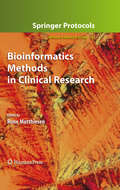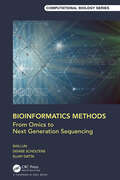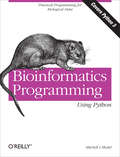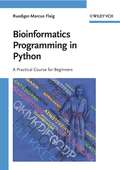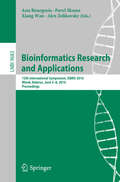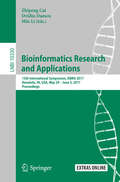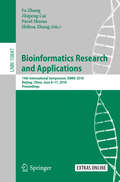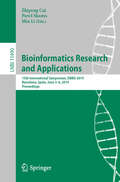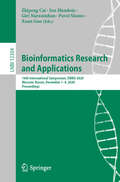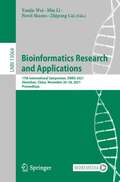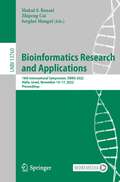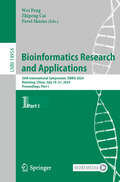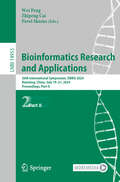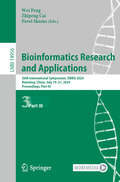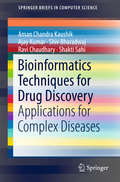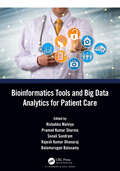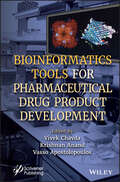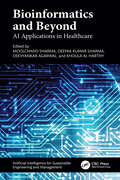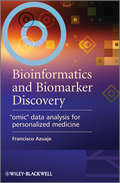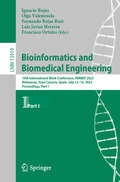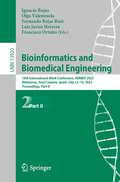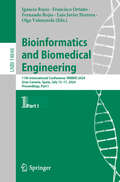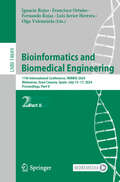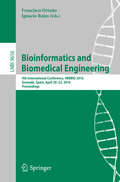- Table View
- List View
Bioinformatics Methods in Clinical Research (Methods in Molecular Biology #593)
by Rune MatthiesenIntegrated bioinformatics solutions have become increasingly valuable in past years, as technological advances have allowed researchers to consider the potential of omics for clinical diagnosis, prognosis, and therapeutic purposes, and as the costs of such techniques have begun to lessen. In Bioinformatics Methods in Clinical Research, experts examine the latest developments impacting clinical omics, and describe in great detail the algorithms that are currently used in publicly available software tools. Chapters discuss statistics, algorithms, automated methods of data retrieval, and experimental consideration in genomics, transcriptomics, proteomics, and metabolomics. Composed in the highly successful Methods in Molecular BiologyTM series format, each chapter contains a brief introduction, provides practical examples illustrating methods, results, and conclusions from data mining strategies wherever possible, and includes a Notes section which shares tips on troubleshooting and avoiding known pitfalls. Informative and ground-breaking, Bioinformatics Methods in Clinical Research establishes a much-needed bridge between theory and practice, making it an indispensable resource for bioinformatics researchers.
Bioinformatics Methods: From Omics to Next Generation Sequencing (Chapman & Hall/CRC Computational Biology Series)
by Sujay Datta Shili Lin Denise ScholtensThe past three decades have witnessed an explosion of what is now referred to as high-dimensional `omics' data. Bioinformatics Methods: From Omics to Next Generation Sequencing describes the statistical methods and analytic frameworks that are best equipped to interpret these complex data and how they apply to health-related research. Covering the technologies that generate data, subtleties of various data types, and statistical underpinnings of methods, this book identifies a suite of potential analytic tools, and highlights commonalities among statistical methods that have been developed. An ideal reference for biostatisticians and data analysts that work in collaboration with scientists and clinical investigators looking to ensure rigorous application of available methodologies. Key Features: Survey of a variety of omics data types and their unique features Summary of statistical underpinnings for widely used omics data analysis methods Description of software resources for performing omics data analyses
Bioinformatics Programming Using Python: Practical Programming for Biological Data (Animal Guide)
by Mitchell L ModelPowerful, flexible, and easy to use, Python is an ideal language for building software tools and applications for life science research and development. This unique book shows you how to program with Python, using code examples taken directly from bioinformatics. In a short time, you'll be using sophisticated techniques and Python modules that are particularly effective for bioinformatics programming.Bioinformatics Programming Using Python is perfect for anyone involved with bioinformatics -- researchers, support staff, students, and software developers interested in writing bioinformatics applications. You'll find it useful whether you already use Python, write code in another language, or have no programming experience at all. It's an excellent self-instruction tool, as well as a handy reference when facing the challenges of real-life programming tasks.Become familiar with Python's fundamentals, including ways to develop simple applicationsLearn how to use Python modules for pattern matching, structured text processing, online data retrieval, and database accessDiscover generalized patterns that cover a large proportion of how Python code is used in bioinformaticsLearn how to apply the principles and techniques of object-oriented programmingBenefit from the "tips and traps" section in each chapter
Bioinformatics Programming in Python: A Practical Course for Beginners
by Ruediger-Marcus FlaigThis first introductory book designed to train novice programmers is based on a student course taught by the author, and has been optimized for biology students without previous experience in programming. By interspersing theory chapters with numerous small and large programming exercises, the author quickly shows readers how to do their own programming, and throughout uses anecdotes and real-life examples from the biosciences to 'spice up' the text. This practical book thus teaches essential programming skills for life scientists who want -- or need -- to write their own bioinformatics software tools.
Bioinformatics Research and Applications: 12th International Symposium, ISBRA 2016, Minsk, Belarus, June 5-8, 2016, Proceedings (Lecture Notes in Computer Science #9683)
by Anu Bourgeois Pavel Skums Xiang Wan Alex ZelikovskyThis book constitutes the proceedings of the 12th International Symposium on Bioinformatics Research and Applications, ISBRA 2016, held in Minsk, Belarus, in June 2016. The 25 papers presented in this volume were carefully reviewed and selected from 77 submissions. They were organized in topical sections named: next generation sequencing data analysis; protein-protein interactions and networks; protein and RNA structure; phylogenetics; sequence analysis; and statistical methods.
Bioinformatics Research and Applications: 13th International Symposium, ISBRA 2017, Honolulu, HI, USA, May 29 – June 2, 2017, Proceedings (Lecture Notes in Computer Science #10330)
by Zhipeng Cai, Ovidiu Daescu and Min LiThis book constitutes the proceedings of the 13th International Symposium on Bioinformatics Research and Applications, ISBRA 2017, held in Honolulu, HI, USA, in May/June 2017. The 27 full papers presented together with 18 short papers and 24 invited abstracts were carefully reviewed and selected from 131 submissions. They cover topics such as: biomarker discovery; biomedical databases and data integration; biomedical text mining and ortologies; biomolecular imaging; comparative genomics; computational genetic epidemiology; computational proteomics; data mining and visualization; gene expression analysis; genome analysis; high-performance bio-computing; metagenomics; molecular evolution; molecular modelling and simulation; next-generation sequencing data analysis; pattern discovery and classification; population genetics; software tools and applications; structural biology; and systems biology.
Bioinformatics Research and Applications: 14th International Symposium, ISBRA 2018, Beijing, China, June 8-11, 2018, Proceedings (Lecture Notes in Computer Science #10847)
by Pavel Skums Zhipeng Cai Fa Zhang Shihua ZhangThis book constitutes the proceedings of the 14th International Conference on Bioinformatics Research and Applications, ISBRA 2018, held in Beijing, China, in June 2018.The 24 full and 10 short papers presented in this volume were carefully reviewed and selected from a total of 138 submissions. They were organized in topical sections named: network analysis and modelling; genomic data analysis; cancer data analysis; structure and interaction; HPC and CryoEM; machine and deep learning; data analysis and methodology; analysis and visualization tools; and RNA-Seq data analysis.
Bioinformatics Research and Applications: 15th International Symposium, ISBRA 2019, Barcelona, Spain, June 3–6, 2019, Proceedings (Lecture Notes in Computer Science #11490)
by Min Li Pavel Skums Zhipeng CaiThis book constitutes the proceedings of the 15th International Symposium on Bioinformatics Research and Applications, ISBRA 2019, held in Barcelona, Spain, in June 2019. The 22 full papers presented in this book were carefully reviewed and selected from 95 submissions. They were organized in topical sections named: genome analysis; systems biology; computational proteomics; machine and deep learning; and data analysis and methodology.
Bioinformatics Research and Applications: 16th International Symposium, ISBRA 2020, Moscow, Russia, December 1–4, 2020, Proceedings (Lecture Notes in Computer Science #12304)
by Xuan Guo Ion Mandoiu Pavel Skums Zhipeng Cai Giri NarasimhanThis book constitutes the proceedings of the 16th International Symposium on Bioinformatics Research and Applications, ISBRA 2020, held in Moscow, Russia, in December 2020. The 23 full papers and 18 short papers presented in this book were carefully reviewed and selected from 131 submissions. They were organized in topical sections named: genome analysis; systems biology; computational proteomics; machine and deep learning; and data analysis and methodology.
Bioinformatics Research and Applications: 17th International Symposium, ISBRA 2021, Shenzhen, China, November 26–28, 2021, Proceedings (Lecture Notes in Computer Science #13064)
by Min Li Pavel Skums Zhipeng Cai Yanjie WeiThis book constitutes the proceedings of the 17th International Symposium on Bioinformatics Research and Applications, ISBRA 2021, held in Shenzhen, China, in November 2021. The 51 full papers presented in this book were carefully reviewed and selected from 135 submissions. They were organized in topical sections named: AI and disease; computational proteomics; biomedical imaging; drug screening and drug-drug interaction prediction; Biomedical data; sequencing data analysis.
Bioinformatics Research and Applications: 18th International Symposium, ISBRA 2022, Haifa, Israel, November 14–17, 2022, Proceedings (Lecture Notes in Computer Science #13760)
by Zhipeng Cai Serghei Mangul Mukul S. BansalThis book constitutes the proceedings of the 18th International Symposium on Bioinformatics Research and Applications, ISBRA 2022, held in Haifa, Israel, in November 14–17, 2022.The 30 full papers and 4 short papers presented in this book were carefully reviewed and selected from 72 submissions. They were organized in topical sections named: AI and disease; computational proteomics; biomedical imaging; drug screening and drug-drug interaction prediction; Biomedical data; sequencing data analysis.
Bioinformatics Research and Applications: 19th International Symposium, ISBRA 2023, Wrocław, Poland, October 9–12, 2023, Proceedings (Lecture Notes in Computer Science #14248)
by Xuan Guo Alexander Zelikovsky Serghei Mangul Murray PattersonThis book constitutes the refereed proceedings of the 19th International Symposium on Bioinformatics Research and Applications, ISBRA 2023, held in Wrocław, Poland, during October 9–12, 2023.The 28 full papers and 16 short papers included in this book were carefully reviewed and selected from 89 submissions. They were organized in topical sections as follows: reconciling inconsistent molecular structures from biochemical databases; radiology report generation via visual recalibration and context gating-aware; sequence-based nanobody-antigen binding prediction; and hist2Vec: kernel-based embeddings for biological sequence classification.
Bioinformatics Research and Applications: 20th International Symposium, ISBRA 2024, Kunming, China, July 19–21, 2024, Proceedings, Part I (Lecture Notes in Computer Science #14954)
by Pavel Skums Zhipeng Cai Wei PengThis book constitutes the refereed proceedings of the 20th International Symposium on Bioinformatics Research and Applications, ISBRA 2024, held in Kunming, China, in July 19–21, 2024. The 93 full papers included in this book were carefully reviewed and selected from 236 submissions. The symposium provides a forum for the exchange of ideas and results among researchers, developers, and practitioners working on all aspects of bioinformatics and computational biology and their applications.
Bioinformatics Research and Applications: 20th International Symposium, ISBRA 2024, Kunming, China, July 19–21, 2024, Proceedings, Part II (Lecture Notes in Computer Science #14955)
by Pavel Skums Zhipeng Cai Wei PengThis book constitutes the refereed proceedings of the 20th International Symposium on Bioinformatics Research and Applications, ISBRA 2024, held in Kunming, China, in July 19–21, 2024. The 93 full papers included in this book were carefully reviewed and selected from 236 submissions. The symposium provides a forum for the exchange of ideas and results among researchers, developers, and practitioners working on all aspects of bioinformatics and computational biology and their applications.
Bioinformatics Research and Applications: 20th International Symposium, ISBRA 2024, Kunming, China, July 19–21, 2024, Proceedings, Part III (Lecture Notes in Computer Science #14956)
by Pavel Skums Zhipeng Cai Wei PengThis book constitutes the refereed proceedings of the 20th International Symposium on Bioinformatics Research and Applications, ISBRA 2024, held in Kunming, China, in July 19–21, 2024. The 93 full papers included in this book were carefully reviewed and selected from 236 submissions. The symposium provides a forum for the exchange of ideas and results among researchers, developers, and practitioners working on all aspects of bioinformatics and computational biology and their applications.
Bioinformatics Techniques for Drug Discovery: Applications For Complex Diseases (SpringerBriefs in Computer Science)
by Ajay Kumar Aman Chandra Kaushik Shiv Bharadwaj Ravi Chaudhary Shakti SahiThe application of bioinformatics approaches in drug design involves an interdisciplinary array of sophisticated techniques and software tools to elucidate hidden or complex biological data. This work reviews the latest bioinformatics approaches used for drug discovery. The text covers ligand-based and structure-based approaches for computer-aided drug design, 3D pharmacophore modeling, molecular dynamics simulation, the thermodynamics of ligand−receptor and ligand−enzyme association, thermodynamic characterization and optimization, and techniques for computational genomics and proteomics.
Bioinformatics Tools and Big Data Analytics for Patient Care
by Pramod Kumar Sharma Balamurugan Balusamy Rajesh Kumar Dhanaraj Rishabha Malviya Sonali SundramNowadays, raw biological data can be easily stored as databases in computers but extracting the required information is the real challenge for researchers. For this reason, bioinformatics tools perform a vital role in extracting and analyzing information from databases. Bioinformatics Tools and Big Data Analytics for Patient describes the applications of bioinformatics, data management, and computational techniques in clinical studies and drug discovery for patient care. The book gives details about the recent developments in the fields of artificial intelligence, cloud computing, and data analytics. It highlights the advances in computational techniques used to perform intelligent medical tasks. Features: • Presents recent developments in the fields of artificial intelligence, cloud computing, and data analytics for improved patient care. • Describes the applications of bioinformatics, data management, and computational techniques in clinical studies and drug discovery. • Summarizes several strategies, analyses, and optimization methods for patient healthcare. • Focuses on drug discovery and development by cloud computing and data-driven research. The targeted audience comprises academics, research scholars, healthcare professionals, hospital managers, pharmaceutical chemists, the biomedical industry, software engineers, and IT professionals.
Bioinformatics Tools for Pharmaceutical Drug Product Development
by Krishnan Anand Vivek Chavda Vasso ApostolopoulosBIOINFORMATICS TOOLS FOR Pharmaceutical DRUG PRODUCT DLEVELOPMENT A timely book that details bioinformatics tools, artificial intelligence, machine learning, computational methods, protein interactions, peptide-based drug design, and omics technologies, for drug development in the pharmaceutical and medical sciences industries. The book contains 17 chapters categorized into 3 sections. The first section presents the latest information on bioinformatics tools, artificial intelligence, machine learning, computational methods, protein interactions, peptide-based drug design, and omics technologies. The following 2 sections include bioinformatics tools for the pharmaceutical sector and the healthcare sector. Bioinformatics brings a new era in research to accelerate drug target and vaccine design development, improving validation approaches as well as facilitating and identifying side effects and predicting drug resistance. As such, this will aid in more successful drug candidates from discovery to clinical trials to the market, and most importantly make it a more cost-effective process overall. Readers will find in this book: Applications of bioinformatics tools for pharmaceutical drug product development like process development, pre-clinical development, clinical development, commercialization of the product, etc.; The ever-expanding application of this novel technology and discusses some of the unique challenges associated with such an approach; The broad and deep background, as well as updates, on recent advances in both medicine and AI/ML that enable the application of these cutting-edge bioinformatics tools. Audience The book will be used by researchers and scientists in academia and industry including drug developers, computational biochemists, bioinformaticians, immunologists, pharmaceutical and medical sciences, as well as those in artificial intelligence and machine learning.
Bioinformatics and Beyond: AI Applications in Healthcare (Artificial Intelligence for Sustainable Engineering and Management)
by Moolchand Sharma Deevyankar Agarwal Deepak Kumar Sharma Khoula Al HarthyThis book is a comprehensive exploration of the dynamic interplay between bioinformatics and artificial intelligence (AI) within the healthcare landscape. This book introduces readers to the foundational principles of bioinformatics and AI, elucidating their integration and collaborative potential.Bioinformatics and Beyond: AI Applications in Healthcare explores the transformative impact of data-driven insights, showcasing the applications of machine learning in diagnostics, personalized medicine, and genomic advancements. The book unveils the pivotal role AI plays in accelerating pharmaceutical research. Moreover, it addresses the practical implementation of AI in clinical decision support systems, while also critically examining challenges and ethical considerations associated with these technologies. Finally, the book looks toward the future, envisioning emerging trends and technologies that promise to reshape the future of healthcare. Aimed at professionals, researchers, and students across diverse disciplines, this book serves as an invaluable guide to understanding and navigating the evolving landscape of AI applications in healthcare.This book is tailored to meet the needs of scientists, researchers, practitioners, professionals, and educators actively engaged in the realms of bioinformatics, artificial intelligence, and healthcare. It will be an indispensable resource for those seeking advanced strategies to address challenges and harness opportunities in the rapidly evolving fields of medical and biomedical research.
Bioinformatics and Biomarker Discovery
by Francisco AzuajeThis book is designed to introduce biologists, clinicians and computational researchers to fundamental data analysis principles, techniques and tools for supporting the discovery of biomarkers and the implementation of diagnostic/prognostic systems.The focus of the book is on how fundamental statistical and data mining approaches can support biomarker discovery and evaluation, emphasising applications based on different types of "omic" data. The book also discusses design factors, requirements and techniques for disease screening, diagnostic and prognostic applications.Readers are provided with the knowledge needed to assess the requirements, computational approaches and outputs in disease biomarker research. Commentaries from guest experts are also included, containing detailed discussions of methodologies and applications based on specific types of "omic" data, as well as their integration. Covers the main range of data sources currently used for biomarker discoveryCovers the main range of data sources currently used for biomarker discoveryPuts emphasis on concepts, design principles and methodologies that can be extended or tailored to more specific applicationsOffers principles and methods for assessing the bioinformatic/biostatistic limitations, strengths and challenges in biomarker discovery studiesDiscusses systems biology approaches and applicationsIncludes expert chapter commentaries to further discuss relevance of techniques, summarize biological/clinical implications and provide alternative interpretations
Bioinformatics and Biomedical Engineering: 10th International Work-Conference, IWBBIO 2023, Meloneras, Gran Canaria, Spain, July 12–14, 2023, Proceedings, Part I (Lecture Notes in Computer Science #13919)
by Ignacio Rojas Francisco Ortuño Olga Valenzuela Luis Javier Herrera Fernando Rojas RuizThis volume constitutes the proceedings of the 10th International Work-Conference on IWBBIO 2023, held in Meloneras, Gran Canaria, Spain, during July 12-14, 2022. The total of 79 papers presented in the proceedings, was carefully reviewed and selected from 209 submissions. The papers cove the latest ideas and realizations in the foundations, theory, models, and applications for interdisciplinary and multidisciplinary research encompassing disciplines of computer science, mathematics, statistics, biology, bioinformatics, and biomedicine.
Bioinformatics and Biomedical Engineering: 10th International Work-Conference, IWBBIO 2023, Meloneras, Gran Canaria, Spain, July 12–14, 2023, Proceedings, Part II (Lecture Notes in Computer Science #13920)
by Ignacio Rojas Francisco Ortuño Olga Valenzuela Luis Javier Herrera Fernando Rojas RuizThis volume constitutes the proceedings of the 10th International Work-Conference on IWBBIO 2023, held in Meloneras, Gran Canaria, Spain, during July 12-14, 2022. The total of 79 papers presented in the proceedings, was carefully reviewed and selected from 209 submissions. The papers cove the latest ideas and realizations in the foundations, theory, models, and applications for interdisciplinary and multidisciplinary research encompassing disciplines of computer science, mathematics, statistics, biology, bioinformatics, and biomedicine.
Bioinformatics and Biomedical Engineering: 11th International Conference, IWBBIO 2024, Meloneras, Gran Canaria, Spain, July 15–17, 2024, Proceedings, Part I (Lecture Notes in Computer Science #14848)
by Ignacio Rojas Francisco Ortuño Olga Valenzuela Fernando Rojas Luis Javier HerreraThis volume constitutes the proceedings of the 11th International Work-Conference on IWBBIO 2023, held in Gran Canaria, Spain, during July 15-17, 2022. The 54 full papers were carefully reviewed and selected from 148 submissions. They were organized in the following topical sections: Biomarker Identification, Biomedical Engineering, Biomedical Signal Analysis, E-Health.
Bioinformatics and Biomedical Engineering: 11th International Conference, IWBBIO 2024, Meloneras, Gran Canaria, Spain, July 15–17, 2024, Proceedings, Part II (Lecture Notes in Computer Science #14849)
by Ignacio Rojas Francisco Ortuño Olga Valenzuela Fernando Rojas Luis Javier HerreraThis volume constitutes the proceedings of the 11th International Work-Conference on IWBBIO 2023, held in Meloneras, Gran Canaria, Spain, during July 15-17, 2022. The 54 full papers were carefully reviewed and selected from 148 submissions. They were organized in the following topical sections: Healthcare and Diseases, Machine Learning in Bioinformatics, New Advances in Deep Learning in Bioinformatics and Biomedicine, Novel Methodologies and Applications in Bioinformatics and Biomedicine.
Bioinformatics and Biomedical Engineering: 4th International Conference, IWBBIO 2016, Granada, Spain, April 20-22, 2016, Proceedings (Lecture Notes in Computer Science #9656)
by Ignacio Rojas Francisco OrtuñoThis book constitutes the refereed proceedings of the 4th International Conference on Bioinformatics and Biomedical Engineering, IWBBIO 2016, held in Granada, Spain, in April 2016. The 69 papers presented were carefully reviewed and selected from 286 submissions. The scope of the conference spans the following areas: bioinformatics for healthcare and diseases; biomedical image analysis; biomedical signal analysis; computational systems for modeling biological processes; eHealth; tools for next generation sequencing data analysis; assistive technology for people with neuromotor disorders; fundamentals of biological dynamics and maximization of the information extraction from the experiments in the biological systems; high performance computing in bioinformatics, computational biology and computational chemistry; human behavior monitoring, analysis and understanding; pattern recognition and machine learning in the -omics sciences; and resources for bioinformatics.
